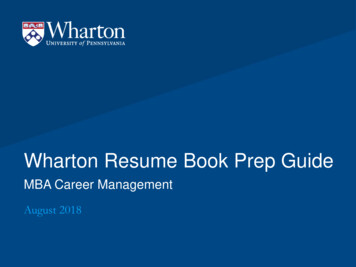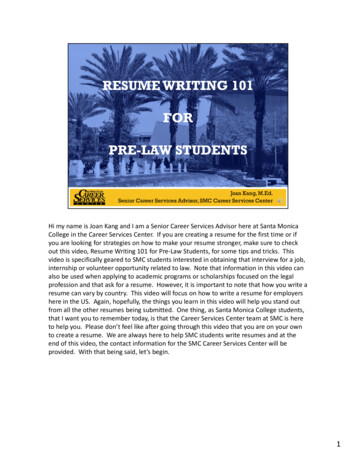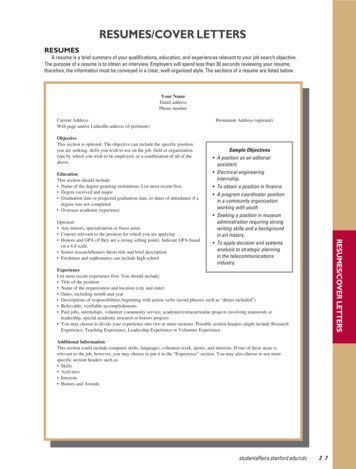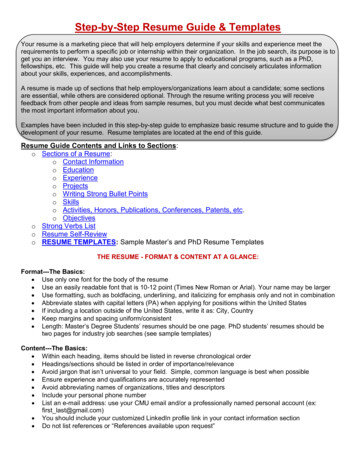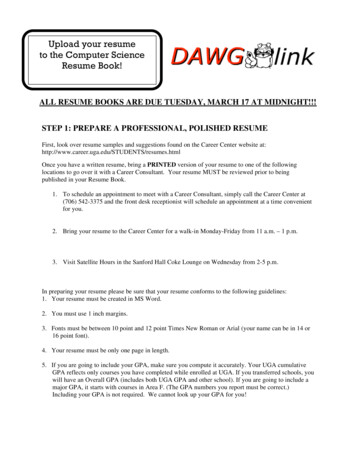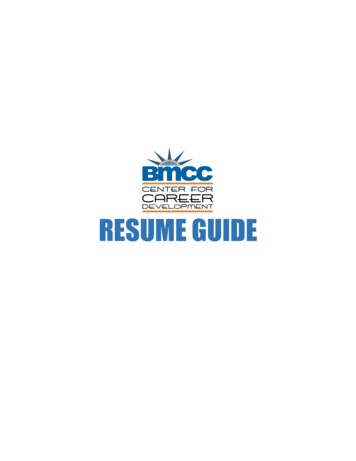
Transcription
DOCUMENT RESUMECE 061 122ED 345 036AUTHORTITLEINSTITUTIONREPORT NOPUB DATENOTEAvAILABLE FROMPUB TYPEEDRS PRIMDESCRIPTORSPitts, Joyce M.Managing Your Personal Finances. Home and GardenBulletins.Agricultural Research Service (DOA), Washington,D.C.; Exten,ion Service (DOA), Washington, D.C.HB-Bull-245-3; HG-Bull-245-1; HG-Bull 245-2Oct 86108p.ConsumerCO 81002Guides Learner)Information Center-X, P.O. Box 100, Pueblo,( 6.50).Classroom Use - Instructional Materials (For(051)MF01/PC05 Plus Postage.Adult Education; *Budgeting; *Consumer Education;Credit (Finance); *Family Financial Resources; *MoneyManagement; Paying for College; PostsecondaryEducation; Retirement; Secondary EducationABSTRACTThis guide is designed to help people of all ages setup a budget and manage their money. It is organized in threesections: the Principles of Managing Your Finances, Financial ToolsUsed in Money Management, and Coping with Change. Section 1 consistsof three chapters. The first chapter introduces the money managementprocess, discusses goal setting, and provides tools to evaluate one'scurrent situation and net worth. Chapter 2 takes the reader throughthe budgeting process and provides tips on recordkeeping and findingsources of advice. The third chapter suggests ways to economize,weighing the pros and cons of buying versus renting housing,determining food expenditures, saving on clothing, and minimizing useof utilities. It ends with a discussion of the costs ofraising, and educating children. Section 2 has chapters on sewing andinvesting, insurance, and consumer credit. Section 3 explainsretirement planning; and economic, financial, and household change.Each chapter includes approximately 25 references. Worksheets areprovided for net worth, setting goals, estimating income, estimatingexpenses, monthly expense record, household expenses, retirementincome, and retirement expenses. ************************tReproductions supplied by EDRS are the best that can be madefrom the original *****.t************************
I.ILa imdbmAI'"ri ;:Vg4e-40,04,1 chSenices.fAGIYOUR PFINAINt74,4,,41-71,aHome and Garden Bulletin No. HG-245U S DEFAS1MEWF OF EDOCAT404debt11, efror,14,40 el. 14.0.4.A1IONAt Rf S4sURC E((V ( IHM ?Jr rfyC.F NT f R E 44,(vAlen} h4, (.pr11,,s'ete,(410 1,on, thp pief (41PII ASIfAirwae,,,, 44.0,1.r:.,11,1)esvP tFrPr, ,,,atte 4mt.( 1(.reortlaur to" oulA1,1,-Poir((s cOotsTe144.1ment dO 1,1 neceS3ii,dy ,evesent of* .31OE AI 4.7s6col of 4x14CrPlor11/ IMP Mit11011Urr"IIII
Pic* United States,A644.Department ng Your Personal FinancesThe Principles of ManagingYour FinancesPrepared byloyce M. Pitts, Home EconomistFamily Economics Research GroupAgricuhund Research ServiceU.S. Department of AgricultureOctober 1986Home and Garden BUiletill No. H6-245-I
PrefaceManaging Your Per.sonal Finance.N is a budgeting gu0e. It is divided into three sectionswhich are available individually or as a set. The total guick is designed to help youdevelop money nunagcment skills. It will teach you how to set goals. bow to meke abudget for your circumstanees. and how to plan for the future. The gui4e eantims information on saving :nd investing. using insurance and credit, and phnning tor retirement:and suggests where to go fix additional help Spedfic information is included on:Developing a budget.1 Using financial tools to carry out your budget.I Recognizing financial and economic conditions mat affect your budget.Set tionIThe Principles of Managing Vonr FinancesliG 245- 1Sedion 2:Financial Tools Used in Money ManawmentH6- 245 2Section 3:Coping With ChangeHO- 245 .3t,pflocie&ISupermIcnikrt ofWahininon. IX 20402rt fftiii%;d11.11are listb.
ContentsintroductionChapter I: Pltuui7C Manage Your Money.1.1The Management Process. 1.1Evaluating Your Current Situation With a Net Worth Statement. 1.2Planning To Reach Your Goals. 1.2Decide Which Goals Are Most Important to You. 1.3Common Goals Throughout the Lite Cycle. 1.3Chapter 2: Achieving Your GoaI. Through Budgeting.1.5The Budgeting Process. 1.5Choosing a Budget Period. 1.6Developing a Successful Budget. 1.6Estimate Your Income. 1.6Estimate Your Expenses. 1.6Balance. 1.8Carrying Out Your Budget. 1.8Become a Good Consumer. 1.8Keep Accurate Records. 1.8Evaluating Your Budget. 1.9Where to Go for Help. 1.9Chapter 3:Ewnotnizing in Your Budget. 1.11Housing. L I IDetermine Your Housing Needs. 1.; iShould You Rent?. 1.12Should You Buy?. 1.12Food. 1.14Determine Food Expenditures. 1.15Clothing. 1.15Determine Clothing Expenditures. 1.16Save on Your Clothing Budget. 1.17Transportation. 1.17The Cost of Owning and Operating an Automobile. 1.17What To Consider When Purchasing a Vehicle. 1.17Utilities. 1.19Children. 1.1919The Cost of Having a Batty.The Cost of Child Care. 1.20The Cost of Raising a Child. 1.21The Cost of Educating a Child. 1.211Work.theas.I. Net Worth Statement. 1.252. Projecting Goals. 1.263. Estimating Your Income, 1.274. Expense Estimate and Budget Balancing Sheet. 1.295. Monthly Expense Record. 1.406. Total Household Exnenses. 1.43
IntroductionOw well are you using resources to manage your finances in today's changingeconomic environment? Resources available include money, time, energy, skills,talents, and knowledge. Good management habits can help you direct and controlthese resources so you can have the things you want and need. As a manager, you oftensubstitute one resource for another. To conserve money. it is often necessary to substitutetime, energy. or talents. For example. you may be able to save money by using 'ime toprepare rnedis ai home instead of eating out. If you can garden or make automotiverepairs, you may be able to save money by performing these skills. By managing allavailable resources you can maintain the kind of lifestyle that you want even duringperiods of financial stress.Effective management of money is a lifelong process. Whether you are a single person, a single parent, a newlywed, a childless couple, a couple with children, or a retiree,you can still benefit from developing good money managemem habits.Good management of time, money, and other resources can help you to:M Increase household income while decreasing outgo.'GIAchieve your goals and those of other household members.fUProtect household members and possessions.
Chapter 1erhaps you have dreamed of sudden!y receiving enough money to pay off all yourbills and become financially secure for life. Even if your dream came true. you.,, probably would find that simply having a lot of money does not end financial worries. Money problems are not restricted to low- and moderate-income households. Whenmore money is available, there are more alternatives to consider. Many people find thatthey can control most financial problems by planning how to manage current income andhow to set goals for the future. This could work for you. too.The Management ProcessThe management process is a Way to reach a particular end. objective. or goat. The basicsteps include:at. Setting goals or objectives.Initiating activities to accomplish these goals.Evaluating and adjusting the activities.Pr Repeating the process until the goals are met.A plan for money management is important for everyone. However, no readymadeplan fits every family, couple, or individual. Every household is differentnot only in thenumber and characteristics of its members, but also in its rallies. needs, wants, andresources. Only you can decide how your money should be spent, taking into considerationyour income, the number and ages of your household members, where you live and work.your preferences. your responsibilities, and your goals for the future. By following amoney management plan. you can be confident that expenses will be met and savings willbe available. A plan can let you know where you stand financially anti prevent emergen.cies from causing a financial strain.Remember three basic concepts when developing a personal money management pian:4 Set realistic objectives. Objectives set too high may lead to frustrations that couldcause you to abandon your plan.Be flexible. Your plan will require adjustments to keep up with your changing lite cyde and financial situation. Do noi make a plan so tight that each new development re-
The Principles of Managing Your Financesquires an entirely new plan.Be Apecifie. State your objedives concisely. If goals are vague. objectives may neverbe met and you and other household members mav have different ideas of what the endproduct will he.EvaluatingYour Current SituationWith a Net WorthStatementPianning To ReachYour (;oakThe first step in developing a money management plan is to evaluate your current situation. An excellent way to do this is to prepare a net worth Ammon. Worksheet 1 onpage 1.25 can be used to add together your assets (what you own) and subtract front thatthe sum of s our liabilities (what you owe). Space is provided for you to calculate your networth statement now and again 1 year from now.To determine the value of your amis. start with cash available. Include your checkingand saving aecounts. as well as your home hank. Now list all your investments, ineludinghonds, mutual ftmds. life insurance cash values, and others. List additional assets. usingthe eurrent market value for your house. real estate. automobiles, jewelry. antiques, andother personal items.To determine your habilitie.s. list the amount that you owe to all your creditors andlenders. Remember to include current hills, charge accounts. mortgage balance, and loansagainst your life insurance.B subtracting liabilities from assets, you can determine your net worth. Look closelyat your final net north figure. Do you Mk n more than you owe? Consider what vou wouldlike this figure to be a year from now. What do you need to do to achieve that goal?Prepare a new net worth statement at the same time each year to reflect the changes inyour finances. The market value of your asset% (house. stock. or cars) may have declinedor risen. You may have paid off one loan or gained another. A new net worth statementnext year will help you decide if the money management plan you are developing no% hashelped put you ahead.An important step in developing a money management plan is to set household and individual goals. Goals are %%ants, needs, and future objectives for your household and itsmembers. Goals may be long-term. intermediate. or immediate.Long-term goals are those you hope to reach in 10 to 20 years or perhaps evenlonger. Long-term goals are often considered first so they can he incorporated into theplan from the start. They are guided by expected changes in your household's life cycleand must sometimes be adjusted tOr future expected income and price changes. Long-termgoals include such things as paying off a mortgage. putting children throngh college, orpros iding fOr a comfortable retirement.Intermediate goals are those to be reached within the next 5 years or so. These goalsmay reflect the ehanges that will occur due to your increased income or larger family. Intermediate goals might include such things as a downpayment on a house, a new car. orincreased hie insurance.Immediate goals arc required now this week, this month. or this year. These arcbasic needs that must he met even at the expense of some future goals. Immediate goalsmay indude paying current hills, maintaining health insurance, and buying ftxxi andclothing.Addressing goals in this order ensures say ings kir long.term and intermediate goalsand prevents immediate guals from pushing future ones aside. If your income is low, youmay be able to meet only immediate goal. But vou still should make intermediate andlongierm plans vshich could help Sou to get ahead in the future.e
Planning Tr; Manage Your MoneyDecide Which Coals Are Most Important to YouThink carefully about your financial goals. Many of us would like to be financially secure.Own a large home, drive a fancy car. educate ourselves or our children. takc 10' g vacations, and so on. Realistically, however, most of us cannot have it all. We mus1 select andwork toward those goals that are most important to us ;.ind ibe ones which we will be ableto obtain. The Wowing process may help you work through your goal-selection decisions.Set goals. Keep a listing of the goals that you and your family hope to achieve. Useworksheet 2 on page 1.26.Rank goals. List your goals in their order of importance to you and your household.Assign dollar values to goals. You will not be able to assign a dollar value to illgoals now. but to most you will. For example. if you plan to buy a new car next year andyou know the amount of the downpayment. put this on your worksheet.Reevaluate your goals. After developing your budget in Chapter 2. take another lookat worksheet 2. You may need to drop, postpone. or revise some of your goals. Deekkhow much change you are willing and able to make. For example. are 'Jou willing tochange jobs or give up other goals in order to achieve a goal that is m.e important toyou? Think about the tradeoffs of saving for longoerin and intermediate goals versus usingincome for current expenses. How much choice do you have? Can you. and do you wantto. cut down on some immediate goals (current expenses) to improve your chames ofmeeting your long-term goals? Refer to your goals often as you plan.Common Coals Throughout the Life C)cleSome goals are universal to all households such as providing for sufficient food. comfortabk shelter. and financial securit). But most goals change as household members progressthrough the life cycle. When you are young and single. goals generally relate to your ownpersonal development. When you are married and have children. your first priorities mayswitch from yourself to your childrenestablishing an educational fund. for example. Different types of households use different ways to meet the same goal. For example. aretired couple may provide for their continued financial security during times of high inflation by cutting expenses. A young couple may seek higher paying employment instead.Look over the following description of household types and determine which groupyour household resembles. Do you have goals similar to the ones stated for your group?Look at the goals for the other groups. They may help you anticipate future needs. Thislisting is not meant to be all-inclusive. However, it can be a starting point in determiningyour current and long-term goals and how those goals may change in years to come.Household Type I: Singles. This household type consists of adults who have nevermarried, or who are widowed or divorced. It includes persons from age 18 to 54 who areconsidered to he self-supporting, even though they may he living with relatives or friendsand snaring some household expenses. Income for this group may not be high. particularlyfor the younger members. Important goals imolve their personal. educational, and financial development.Household Type 2: Single Parents. Members of this household group may also havenever married or are widowed or divorced. Unlike Type 1 households. they are parentsliving with dependent children. The critical finanvial goals for single parents often relate tothe care of their children and themselves.Household Type 3: Young Couples. This household type ;s often called the beginningfamily or the beginning marriage stage. lt is a period of personal and tinancru adjustment
The Principles of Managing Your Financesfor two persons. Ages of couples in this group typically range from about 18 to 34. Thereare no children and there are often two incomes. Important goals involve setting up ahousehold and adjusting to each other's needs.Household Type 4: Young Families. In this growing-family stage, parents aretypically youngage 18 to 34and have dependent children in the household. There maybe two incomes. Critical goals include protecting the family intome and rearing thechildren.Household Type 5: Middle Families. This household type is sometimes referred to asthe contracting family. Parents are typically 35 to 54 years old. Children are "leaving ti-enest" for college, careers, and marriage. Unique goals for this household include providing for the childrrn's college or vocational education, weddings. and the parents' eventual retirement.Household Type 6: Middle Couples. This group consists of persons age 35 to 54without children. This type of household often contains two earners. Income is often quitehigh, making investment maximization and tax minimization important financial goals.Household Type 7: Older Singles. This group contains persons age 55 and older whomay be retired. There is no spouse present in the household. The majority of older singlesare females. The major financial goal is to provide adequate income and reserves that willlast for the balance of the older single's lifetime.Older Couples. This group consists of married couples ages 55Household Typeand over who also may be retired. Their major financial goal is maintenance of an adequate level of living for both persons for life.
Chapter 2o you often find yourself unable to make one paycheck last until the next arrives?Do you meet current expenses hut have little or nothing left to save for the futureIf so. you are a prime candidate for developing a budget. You may have theseproblems whether you earn 50.000 a year or 10.000 a year. Even if you rarely facethese situations, a budget can probably help you achieve more of your goals.The Budgeting ProemA budget is a plan for spending and saving. It requires you to estimate your available income for a particular period of time and decide how to allocate this income toward yourexpenses. A working budget can help you implement your money management plan. Awell-planned budget does several things for you and your household. It can help you:a Prevent impulse spending.rit Decide what you can or cannot affordo Know where your money goes,ti Increase savings,O Decide how to protect against the financial consequences of unemployment, accidents.sickness. aging. and death.A working budget need not he complicated or rigid. However. preparing one takes planning, and following one takes determination, You must do several things to budgetsuecessfully.First. communicate with other members of your household, including older children.Consider each person's needs and wants so that all family members feel they are a part ofthe plan. Everyone may work harder to make the budget a success and k less inclined tooverspend if they realize the consequences. When families fail to communicate aboutmoney matters, it is unlikely that a budget will reflect a workable plan.Second. be prepared to compromise. This is often difficult. Newlyweds. especially.may have problems. Each may have been living en an individual income and not be accustomed to sharing, or may have been in school and dependent on parents. If. for example. one wants to save for things and the other prefers buying on credit, they will need to
The Principles of Managing Your Financesdiscuss the pros and ems of both methods and decide on a middle ground each can accept.A plan cannot succeed unless there is a financial partnership.Third. exercise willpower. Try not to indulge in unnecessary spending. Once yourbudget plan is made. opportunities to overspend will occur daily. Each household memberneeds to encourage the others tt. stick to the plan.Fourth, develop a good reoirdkeeping system. At first, all members of the householdmay need to keep records of what they spend. This will show how well they are followingthe plan anti will allow intermediate adjustments in the level of spending. Recordkeeping isespecially important during the first year of a spending plan when you are trying to find abudget that works best for you. Remember. a good budget is flexible. requires littleclerical time. and most importantly, works for you.Choasinga Budget PeriodDevelopinga Surressful BudgetA budget may cover any convenient period of time a month. 3 months, or a year. for example. Make sure the period you use is long enough to cover the bulk of household .-penses and income. Remember. not all bills come due monthly and every household x.periences some seasonal expenses. Most personal budgets are for 12 months. You cal.begin the 12-month period at any time during the year. If this is your first budget. youmay want to set up a trial plan for a shorter time to see how it works.After setting up your plan, subdivide it into more manageable operating periods. For ayearly budget, divide income and expenses by 12. 24, 26, or 52. depending on your payschedule or when your bills come due. Most paychecks arc received weekly or every 2weeks. Although most bills come due once a month, not all are due at the same time inthe month. Try using each paycheck to pay your daily expenses .rit1 expenses that will bedue within the next week or two. This way you will be able to pay your bills on time.You may also want to allocaw something from each paycheck toward large expenses thatwill he coming due soon.Step 1:Estimate Your incomeTotal the money you expect to receive during the budget period. Use worksheet 3 onpage 1.27 as a guide in estimating your household income. Total all money you willreceive. Begin with regular income that you and your family receivewages, salaries.income earned from a farm or other business. Social Security benefits, pension payments.alimony, child support, veterans' benefits, public assistance trayments, unemployment compensation. allowances, and any t.ther income. Include variable income, such as interestfrom bank accounts and investments, dividends from stock and insurance, rents from prop-erty you own. gifts. and money from any other sources.lf your earnings are inegular. it may be more difficult to estimate your income. It isbetter to underestimate than overestimate income when setting up a budget. Somehouseholds have sufficient income. hut its receipt does not coincide with the arrival ofhills. For these households. planning is very important.Step 2: Estimate i'our ExpensesAher you have determined how much your income will be for the planning period.estimate your expenses. You may want to group expenses into one of three categories:fixed, flexible. or set-asides. Fied expenses are payments that are basically the same
Achieving Your Goals Through Budgetingamounts each month. Fixed regular expenses include such items as rent or mortgagepayments. taxes. and credit installment payments. Fixed irregular expenses are largepayments due once or twice a year. such as insurance premiums. Flexible expenses mayvary from One month to the next. such as amounts spent on food, clothing. utilities, andtransportation. Set-asides are variable amounts of money aciAimulated for special purposes.as for seasonal expenses. savings and emergency funds. and intermediate and long-termgoals.Use old records. receipts, bills, and cancelled checks to estimate future expenses. ifyou arc satisfied with what your dollars have done for you and your family in the past. Ifyou are not satisfied, now is the time for change. Consider which expenses can he cutback and which expenses need to be increased. If you spent a large amount On entertainment. for example. your new budget may reallocate some of this money to a savines account to contribute to some of your future goals.If you do not have past records of spending. or If this is your first budget. the mostaccurate way to find out how much you will need to allow for each expense is to keep arecord of your household spending. Carry a pocket notebook in which you jot down expenditures during a week or pay period and total the amounts at the end of each week.You may prefer to keep an account book in a convenient place at home and make entriesin it. Kept faithfully for a month or two. the record can help you find out what you spendfor categories such as food. housing. utilities, household operation. dieting. transportation. entertainment, and personal items. Use this record to estimate expenses in your planfor future spending. You also need to plan for new situations and changing conditions thatincrease or decrease expenses. For example. Inc cost of your utilities may go up.Total your expenses for a year and divide to determine the amounts that you will haveto allocate to.vard each expense during the budgeting period. Record your estimate foreach budgetliry expense in the space provided on worksheet 4. "Expense Estimate andBudget Balancing Sheettpages 1.29-1.39f. Begin with the regular fixed expenses that youexpect to have. Next, enter those fixed expenses that come due once or twice a year.Many households allocate a definite amount each budget period toward these expenses tospread out the cost.One way to meet major expenses is to set aside money regularly befOre you start tospend. Keep your set-aside funds separate from other funds so you will not be tempted tospend them impulsively. If possible, put them in an account where they will earn interest.You may also plan at this point to set aside a certain amount toward the long-term and intermediate goals you listed on worksheet 2. Saving could be almost as enjoyable as spending. once you accept the idea that saving money is not punishment. hut a systematic wayof reaching your goals. Yoe do without some things now in anticipation of buying whatwill give you greater satisfaction later.You may want to clear up debts now by doubling up on your installment payments orputting aside an extra amount in your savings fund to be used for this purpose. Also.when you start to budget, consider designating a small amount of money for emergencies.Extras always come up at the most inopportune times. Every household experiences occasamal minor crises too small to be covered by insurance but too large to be absorbed intothe day-to-day budget. Examnles may be a blown-out tire or an appliance that needsreplacing. Decide how large a cushion you want fin meeting emergencies. As your fundreaches the figure you have allowed fin emergencies, you can start sa.ing for 7.omethioeeke. Now, record numey allocated for occasional major expenses. future goals. savings.emergenvies, and any other set-asides in the space provided Itir them on worksheet 4.After you have entered your fixed expenses and your set-asides. you are ready to consider your flexible expenses. Consider including here a personal allowance or "mad
The Principles of Managing Your Financesmoney" for ouch member of the household. A little spending money that does not have tobe accounted for gives everyone a sense of freedom and takes some of the tedium out ofbudget ingStep 3: BalanceNow you are ready for the balancing act. Compare your total expected income with thetotal of your planned expenses for the budget period. If your planned budget equals yourestimated future income, ate you satisfied with this outcome? Have you left enough leewayfor emergencies and errors? If your expenses add up to more than your income, lookagain at all parts of the plan. Where can you cut down? Where are you overspending?You may have to decide which things are most important to you and which ones can wait.You may be able to do some trimming on your flexible expenses.Once you have cut back your flexible expenses. scan your fixed expenses. Maybe youcan make some sizable reductions here, too. Rent is a big item in a budget. Somehouseholls may want to consider moving to a lower priced apartment or making differentliving arrangements. Others turn in a too-expensive car and seek less expensive transportation. Look !me!, at worksheet 2. "Projecting Goals."You may need to reallocate some ofthis income to meet current expenses. Perhaps ::ou may have to consider saving for someof your goals at a later date.If you have cut back as much as you think Au can or arc willing to do and your planstill calls for more than you make, consider ways to increase your income. You may wantto look for a better paying job. or a part time second job may be the answer. If only onespouse is employed, consider becoming a dual-earner family. Thc children may be able toearn their school lunch and extra spending money by 'ming odd jobs in yourneighborhood. such as cutting grass or bahysitting. Older children can work part-time onweekends to help out. Another possibility, especially for short-term problems. is to drawon savings. These arc decisions each individual household has to make.If your income exceeds your estimate of expensesgood! You may decide to satisfymore of your immediate wants or to increase the amount your family is setting aside forfuture goals.Carrying Out Your BudgetAfter your plan is completed, put it to work. This is when your determination must reallycome into play. Can you and your family resist impulse spending"!Become a Good ConsumerA vital part of carrying out the budget is being a goixl consumer. Learn to get the mostfor your money. to recognize quality. avoid waste. and to realize time costs as well asmoney costs in making consumer decisions.Keep Accurate RecordsAccurate financial records are accessary to keep track of your household's actual moneyinflow and outgo. A successful system requires cooperation from everyone in thehousehold. Receipts can be kept and entered at the end of each budget period in a91F
Achkving Your Goals Through BudgetingMonthly Expense Record like the one on pages 1.40-1.41 (worksheet 5). It isSOMetinles a good idea to write on the back of each receipt what the purchase was for.who made it. and the date. Decide which family member win be responsible for payingbills or making purchases and decide who will keep the record system up to date.The household business recordkeeping s
sections: the Principles of Managing Your Finances, Financial Tools Used in Money Management, and Coping with Change. Section 1 consists of three chapters. The first chapter introduces the money management process, discusses goal setting, and provides tools to evaluate one's current si




